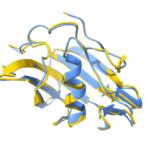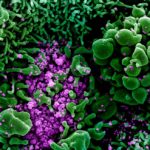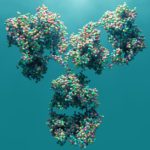Researchers have leveraged machine learning to create proteins that toggle between two different shapes in response to biological triggers, overcoming a limiting challenge in computational protein design and broadening the potential functionality of designed proteins. Study co-author Banumathi Sankaran, a research scientist in the Molecular Biophysics and Bioimaging Division, used the Advanced Light Source (ALS) beamlines in the Berkeley Center for Structural Biology (BCSB) to validate results with X-ray crystallography data.
Congratulations to Biosciences Area Director’s Award Recipients
Each year, the Berkeley Lab Director’s Achievement Award program recognizes outstanding contributions by employees to all facets of Lab activities. Several Biosciences Area personnel are among the 2022 honorees.
BCSB Confirms AI-predicted Structure of Key Rotavirus Site
The effects of a stomach flu can range from pesky to deadly. Researchers recently used an AI program to predict the structure of a common rotavirus and collaborated with a Biosciences researcher working at the Advanced Light Source to validate their novel finding.
BCSB Determines Interactions of Potential Inhibitor with SARS-CoV-2 Protease
Researchers from the Baylor College of Medicine employed previously constructed DNA-encoded chemistry technology (DEC-tec) libraries to identify several candidate molecules that could inhibit the action of Mpro, the main protease of SARS-CoV-2. In a recent study, the researchers described CDD-1713, a new inhibitor to the enzyme Mpro that is involved in propagating the virus. The X-ray crystallographic data, which was collected by Banumathi Sankaran in the Molecular Biophysics and Integrated Bioimaging Division, allowed the researchers to determine that CDD-1713 inhibits the activity of Mpro by binding in the active site of this enzyme.
Providing New Technologies for Vaccine Development
A team of scientists led by David Baker at the University of Washington developed a method to design artificial proteins to serve as a framework for viral antigens. Their study was published recently in the journal eLife. Berkeley Lab scientists collected data at the Advanced Light Source to visualize the atomic structure and determine the dynamics of the designed scaffolds.
- 1
- 2
- 3
- 4
- Next Page »
Was this page useful?








